Article and all photos by Joe Mock, BaseballParks.com
All rights reserved
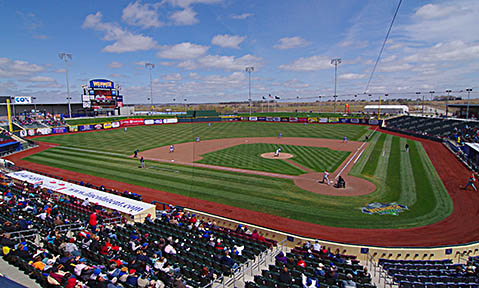 |
There’s quite a story behind the new park for the Omaha Storm Chasers of the Pacific Coast League. It’s a story of high hopes, then eviction, long shots and, finally, a very happy ending.
The team known as the Omaha Royals had played at venerable Rosenblatt Stadium on the south side of Omaha for 41 years, every one of them as the Triple-A farm team of the KC Royals. Every June, the team would have to go on an extended road trip so that the spectacle of the College World Series could descend on the ballpark. As the CWS grew over the years, expansion after expansion occurred at The ‘Blatt, finally resulting in a capacity of 24,000.
This wasn’t ideal for the O-Royals, as their home park was anything but intimate. And since there were so many seats available for every game, fans typically didn’t bother buying tickets in advance, because they knew no game would sell out.
| Ballpark Stats |
 |
| Team: Omaha Storm Chasers of the Triple-A Pacific Coast League |
| First game: April 16, 2011, a 2-1 win over Nashville |
| Capacity: 9,023, of which 6,434 are fixed seats |
| Architect: DLR Group |
| Construction: Weitz |
| Price: $30 million, not including the land (which was donated) |
| Home dugout: 3B side |
| Field points: Northeast |
| Playing surface: Kentucky bluegrass |
| Betcha didn’t know: Fans have a choice of parking in a free lot, or paying $2 to park closer to the stadium’s entryway |
Would the O-Royals have liked a new ballpark? Probably, but they made the most of the situation in mammoth, aging Rosenblatt. Besides, the team knew that Omaha was definitely a market that could support a Triple-A team, and the relationship with their parent club in Kansas City was solid — as evidenced by a Player Development Contract that dated back to 1969, the first year the expansion Royals came on the American League scene.
Then everything changed when the City of Omaha decided they wanted to lock in the College World Series for the long-term. Other cities, noticeably Indianapolis, had started making noises that the NCAA should permit other markets to host this premier event, just as basketball’s Final Four moves from city to city each spring. Omaha had been the host of the annual event since 1950, and they knew that the CWS meant millions of dollars to the city’s hotels, restaurants, rental-car companies, etc. They weren’t about to give up the event without a fight.
That fight meant improved facilities. For all of its expansion over the years, Rosenblatt simply didn’t possess the niceties that modern-day fans and the press demand. The City decided to do one of two things: rebuild Rosenblatt at a projected cost of about $80 million, or build a brand new park in downtown Omaha at a cost that would exceed $100 million. In May of 2007, the City chose the latter. This surprised quite a few people familiar with the situation, such as Paul Fiarkoski, a blogger for Collegebaseball360.com who grew up in the Rosenblatt neighborhood. “In my opinion, the Rosenblatt facility was in as good a shape as I have ever seen it” at the time the city made the decision to jettison it. “You have to remember that the stadium just had a several-million-dollar makeover in 2002.”
Also, in a news story on local station KETV, it was reported the City included lease revenue from the O-Royals’ use of a new stadium in their initial projections to justify constructing a brand-new facility. However, it appears the City might’ve made this assumption without first discussing the matter with the O-Royals.
Hindsight being 20/20, it certainly appears that the city was much more concerned about what the NCAA thought than how the pro team (that had played seventy-some games a year there for the past four decades) felt. In September 2007, when the O-Royals were finally invited to participate in the discussions regarding a new stadium, the team was told that if they were interested in playing in the new facility, they would receive no money from the naming rights, the parking or the concessions. In short, even though they would be using the facility for five months each year, they would be second-class citizens to the NCAA, who would use the park for two weeks each June. The team said no thanks to that deal, and I can’t blame them.
| The ‘Blatt |
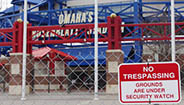 |
| Several years before the College World Series came to Omaha, Johnny Rosenblatt Stadium was built for pro baseball. As Werner Park opened, the ‘Blatt was sitting empty, awaiting demolition. |
“Back in the 1990s, it was the Omaha Royals’ owners — Warren Buffet in particular — who pumped millions of dollars into Rosenblatt to help keep the College World Series in Omaha,” recalls Fiarkoski. “If you fast forward to 2008, the City of Omaha’s leaders were working to make a deal with the NCAA to keep the College World Series in Omaha at taxpayer expense. It seemed like the needs of the Royals, the more loyal long-term tenant, were a complete afterthought then.
“The Royals were a great community partner, too,” he added. “They did a lot to give back to local schools and non-profit groups and I think their efforts were completely discounted by the City of Omaha. It’s only odd the way things turned out if you don’t understand Omaha politics. For the rest of us (who have lived there), it’s crystal clear.”
You might think that the City would’ve been content to let the O-Royals stay at Rosenblatt, but they had no interest in that. The City wanted to demolish the old stadium so the renowned zoo next door could expand. “Even though the City hadn’t talked to us yet, we knew as early as May of 2007 that 2010 would be our last year at Rosenblatt,” said Martie Cordaro, Vice President and General Manager of the newly named Storm Chasers. He was the O-Royals’ assistant GM in 2007 before becoming GM in 2008 and adding the title of VP in 2009. In August of 2009, when the team formally told the City that they weren’t interested in moving into the new downtown park, “a dozen inquiries from cities around the country poured in,” Cordaro said. Three cities stood out because they either had a Triple-A-level stadium (Tucson and Vancouver) or were willing to build one (Sugar Land, Texas). At that point, “we felt that it was a 70-80% likelihood that we would be leaving the Omaha market.” They didn’t want to vacate this metro area of 865,000 residents, but they knew that they were being evicted from Rosenblatt and had nowhere else to play.
Enter Sarpy County, an area of 247 square miles, making it the smallest county in the state of Nebraska. Its geography might not be the biggest, but its population is growing rapidly, and they were interested in developing an entertainment/retail complex. They felt a new ballpark would be the perfect centerpiece for it. Following an independent feasibility study that showed that Sarpy County (which is just south of Omaha) could indeed support a 10,000-seat ballpark that would cost $41 million to build, 13 possible locations were considered. At this point, “we still felt it was about 50/50 that we were going to have to leave the area,” Cordaro now admits.
Noted sports architect DLR Group was brought on to help the process. When they helped reduce that list of 13 down to five by “eliminating sites that were too small or that didn’t have sufficient accessibility,” according to DLR’s Design Leader Greg Garlock, things became a little clearer for the team. When a cornfield along Highway 370 about three miles east of Interstate 80 was chosen as the site with the best potential, the O-Royals could clearly see the future. In March of 2009, the team signed an agreement with the Sarpy County Board of Commissioners to play in the to-be-built ballpark for the next 25 seasons.
The Setting
A total of 31 acres was devoted to the ballpark and its parking lots, which was a nice, expansive piece of ground. Not only that, the land didn’t cost the County or the team any money. That’s because this 31-acre parcel is actually a piece of a 310-acre tract that is slated for “mixed use,” and the land for Werner Park was donated by its owners so the facility would be the centerpiece of the development. Roger Langpaul and his company 360 Real Estate envision a mixture of retail stores, entertainment venues and residences, all surrounding the ballpark. This tract is owned by Langpaul’s wife’s family, and they selected a wonderfully appropriate name for the development: Pennant Place.
As the park opened in April of 2011, none of the development around the park had yet been constructed — although a fair amount of grading work is going on (below left). That means that the acres and acres surrounding the ballpark and its parking lots are rolling pasture land … which is nice because that’s how much of Sarpy County looks anyway. It’s a lovely setting, and if the development is done in a tasteful way (and all of the renderings and site plans seem to indicate it will be), it could end up being a gorgeous commercial area.
 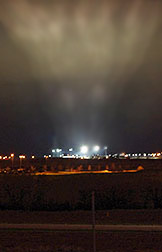 |
“We couldn’t be more excited to have a first-class, state-of-the-art ballpark here,” Langpaul told me. “It’s a huge plus for the rest of the development because with at least 72 baseball games and an additional 50 or 60 events every year, it will be a big traffic generator for the restaurants, bars, family-entertainment venues and retail stores that we’ll have here. Plus Highway 370 is a major, major thoroughfare. We really believe this (development) will have an economic benefit for the entire area.”
In addition to a small stream that flows just over a rise beyond the park’s right field, the exact site of the ballpark is well-chosen for another reason: it’s on a slight hill. This gives the ballpark great visibility from miles away — including along heavily traveled I-80. And when the lights are on for a night game, the park is like a beacon that can’t be missed from the Interstate. And when clouds are hanging low, the scene is even more impressive.
However, I don’t advise you to do what I did, which was to stop on the shoulder of I-80 to take the picture on the right-hand side above. You see, a state trooper pulled over to see what I was up to. No, I wasn’t arrested or given a ticket (the officer couldn’t have been nicer, as almost everyone in the Midwest is), but pulling over at night wasn’t the safest thing for me to do. But I just had to capture that striking scene!
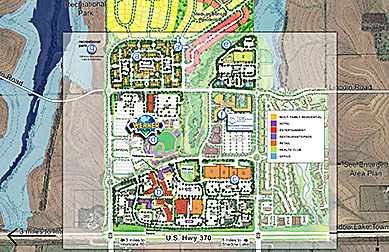 |
When Pennant Place is completely built out — and Langpaul said that “it could be five to seven years to complete the development, and we’re prepared to see it through” — there will be single-family homes on the north side, a recreation area to the west, condos just north of the ballpark, an office park, a retirement community, a health club, a theater, and a number of shops and restaurants. “And accessibility will be excellent,” Langpaul added, “because there will be five different avenues of entrance and egress. Some of the sites they looked at (for the ballpark) only had one.”
The Exterior
Once the commercial development occurs around the park, people will start to notice all aspects of the stadium’s exterior — even the areas beyond the outfield. Until then, the area around the ticket windows and entryway will attract all of the attention.
Good thing a lot of thought went into it — although there’s one element that the architects didn’t intend!
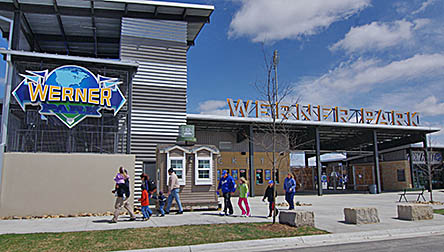 |
The main entry area can be seen in the photo above. Aside from a mild case of monotypographic disharmony (the fonts of the various signs aren’t similar enough for my taste), this is a fine look for the part of the park that most fans will see first. That’s because the majority of the parking is on the third-base side of the facility.
Take a good look at the construction materials in the photo. There is certainly a good amount of Nebraska limestone, with a pattern that is reminiscent of Round Rock’s famed Dell Diamond. But there is also a heavy dose of corrugated metal, and this makes many think of a sturdy storm shelter, which is appropriate with a new team nickname of Storm Chasers.
DLR’s Garlock prefers to think of the look as “agrarian,” to remind fans of all of the storage buildings and silos on the farms that dot the landscape of Sarpy County. “We definitely didn’t want a red-brick ballpark at this location,” he said. And as you look around and see nothing but pasture land for miles around, he added quite an understatement: “We’re not downtown here.”
 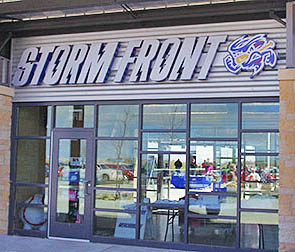  |
“The look and feel of this park blends with Sarpy County perfectly,” is the way team GM Cordaro looks at it.
Just to the left of the gates themselves are the ticket windows, and towering over them is, well, a tower (above left). Half masonry and half corrugated metal, it houses a stairwell that leads to the suites and press level. Next to this tower is a small structure (above right) where you’ll find the will-call windows. This little building does not look anything like the rest of the ballpark’s exterior. As Garlock and I were leaving the ballpark that day, he pointed to the structure and started chuckling. “That was not part of our (architectural) design!”
The outside plaza just in front of the gates is a perfect size, especially when it’s a day game with lots of kids from schools or camps. To the right of the gates is the souvenir store called, cleverly, Storm Front (above center). Too often, the shops in new parks are well inside the stadium. Not here. There are doors that open to the inner concourse and to the outside of the park, facilitating fan access when there is no game going on.
 |
Around on the first-base side of the exterior (above) is sturdy fencing that surrounds picnic tables, one of the seven areas where groups can congregate at Werner Park.
And if you attend a night game, you’ll notice that the words “Werner Park” and “Storm Chasers” near the entryway have very striking lighting. Nice touch — a touch that you don’t find on many other buildings in Sarpy County, whether they be farm buildings or storm shelters!
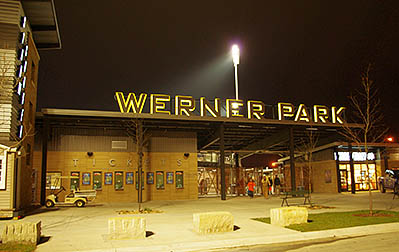 |
I wouldn’t characterize Werner Park as having a stunning, ground-breaking exterior, but it works extremely well considering where the park is located.
Now let’s look inside the park.